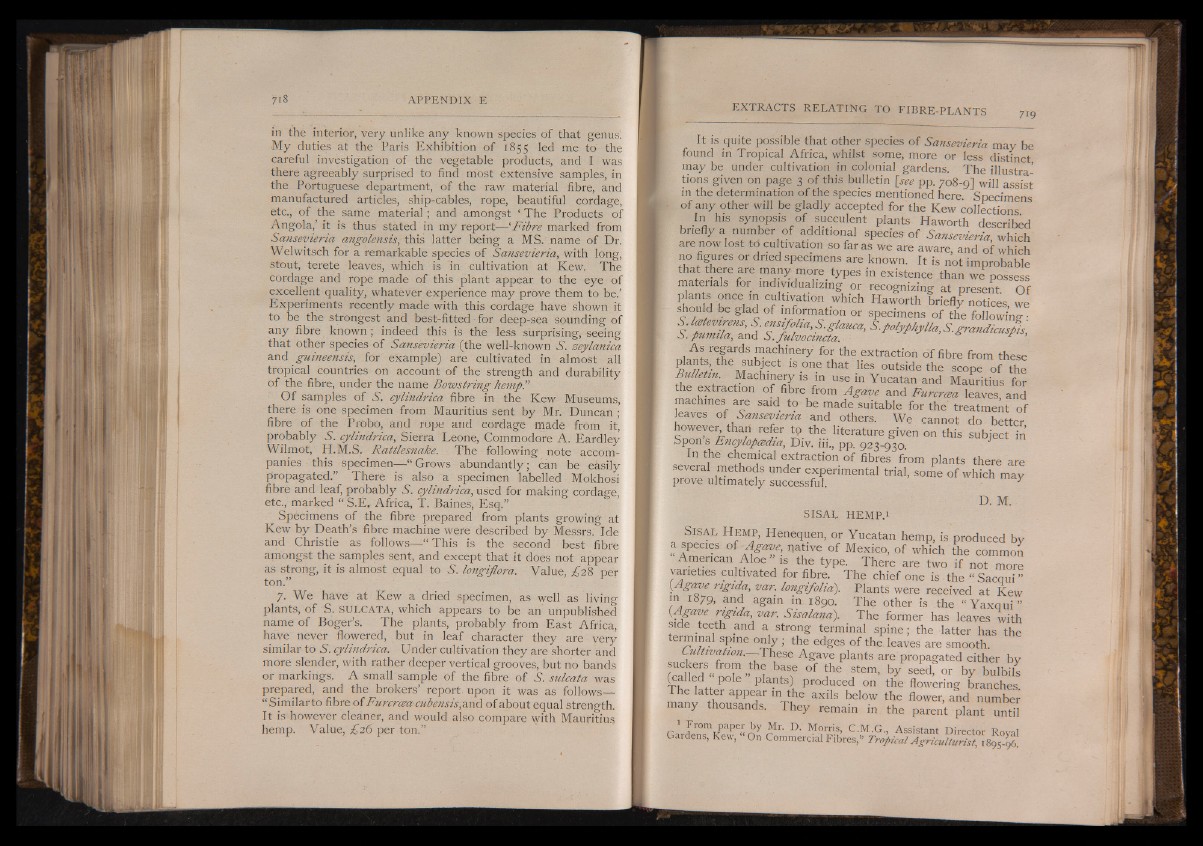
in the interior, very unlike any known species of that genus!
My duties at the Paris Exhibition of 1855 led me to the
careful investigation of the vegetable products, and I was
there agreeably surprised to find most extensive samples, in
the Portuguese department, of the raw material fibre, and
manufactured articles, ship-cables, rope, beautiful cordage,
etc., of the same material; and amongst ‘ The Products of
Angola/ it is thus stated in my report—-Fibre marked from
Sansevieria angolensis, this latter being a MS. name of Dr.
Welwitsch for a remarkable species of Sansevieria, with long,
stout, terete leaves, which is in cultivation at Kew. The
cordage and rope made of this plant appear to the eye of
excellent quality, whatever experience may prove them to be.’
Experiments recently made with this cordage have shown it
to be the strongest and best-fitted for deep-sea sounding of
any fibre known; indeed this is the less surprising,- seeing
that other species of Sansevieria {the well-known S', zeylanica
and guineensis, for example) are cultivated in almost all
tropical countries on account of the strength and durability
of the fibre, under the name Bowstring hemp!'
Of samples of S', cylindrica fibre in the Kew Museums,
there is one specimen from Mauritius sent by Mr. Duncan ;
fibre of the Probo, and rope and cordage made from it,
probably S', cylindrica, Sierra Leone, Commodore A. Eardley
Wilmot, H.M.S. Rattlesnake. The following note accompanies
this specimen— “ Grows abundantly; can be easily
propagated.” There is also 'a specimen labelled Mokhosi
fibre and leaf, probably S', cylindrica, used for making cordage,
etc., marked “ S.E. Africa, T. Baines, Esq.”
Specimens of the fibre prepared from plants growing at
Kew by Death’s fibre machine were described by Messrs! Ide
and Christie as follows— “ This is the second best fibre
amongst the samples sent, and except that it does not appear
as strong, it is almost equal to S', longiflora. Value, A28 per
ton.”
7. We have at Kew a dried specimen, as well as living
plants, of S. SULCATA, which appears to be an unpublished
name of Boger’s. The plants, probably from East Africa,
have never flowered, but in leaf character they are very
similar to S. cylindrica. Under cultivation they are shorter and
more slender, with rather deeper vertical grooves, but no bands
or markings. A small sample of the fibre of S', sulcata was
prepared, and the brokers’ report upon it was as follows—
“ Similar to fibre of Furcrcea cubensis, and of about equal strength.
It is;however cleaner, and would also compare with Mauritius
hemp. Value, £26 per ton.”
It is quite possible that other species of Sansevieria may be
found in Tropical Africa, whilst some, more or less distinct
may be under cultivation in colonial gardens. The illustrations
given on page 3 of this bulletin [see pp. 708-9] will assist
in the determination of the species mentioned here. Specimens
of any other will be gladly accepted for the Kew collections
In his synopsis of succulent plants Haworth described
briefly a number of additional species of Sansevieria which
are now lost to cultivation so far as we are aware, and of which
no figures or dried specimens are known. It is not improbable
that there are many more types m existence than we possess
materials for individualizing or recognizing at present Of
plants once m cultivation which Haworth briefly notices, we
should be glad of information or specimens of the following •
As regards machinery for the extraction of fibre from these
plants, the subject . !s one that lies outside the scope of the
Bulletin. Machinery is in use in Yucatan and Mauritius for
the extraction of fibre from Agave and Furcrcea leaves, and
machines are said to be made suitable for the' treatment of
leaves of Sansevieria and others. We cannot do better
however than refer tp the literature given on this subject in
Spon s Encylop&dia, Div. iii., pp. 923-530.
In thè chemical extraction of fibres from plants there are
several methods under experimental trial, some of which may
prove ultimately successful.
D. M.
SISAL HEMP.1
S i s a l H em p , Henequen, or Yucatan hemp, is produced by
a species of Agave, native of Mexico, of which the common
American Aloe is the type. There are two if not more
varieties cultivated for fibre. The chief one is the “ Sacaui ”
{Agave rigida, var. longifolia). Plants were received at Kew
m 1879, and again in 1890. The other is the “ Y a x a u i”
(Agave rigida var. Sisalana). The former has leaves with
side teeth and a strong terminal spine ; the latter has the
terminal spine only ; the edges of the leaves are smooth.
Cultivation.— These Agave plants are propagated either by
S S S/ f f 1 1 base of SI ^em, by seed, or by bulbils
(called pole plants) produced on the flowering branches.
The latter appear in the axils below the flower, and number
many thousands. They remain in the parent plant until
» From paper by Mr. D. Morris, C .M .G , Assistant Director Rovai
Gardens, Kew, On Commercial Fibres,” Tropical A g r i c u l t u r i s t ^ .